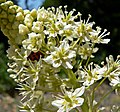bio.wikisort.org - Plant
Toxicoscordion venenosum, with the common names death camas and meadow death camas, is a species of flowering plants in the genus Toxicoscordion, of the Melanthiaceae family. It is native to western North America.
| Toxicoscordion venenosum | |
|---|---|
 | |
| In Kingston Prairie Preserve, near Stayton, Oregon | |
| Scientific classification | |
| Kingdom: | Plantae |
| Clade: | Tracheophytes |
| Clade: | Angiosperms |
| Clade: | Monocots |
| Order: | Liliales |
| Family: | Melanthiaceae |
| Genus: | Toxicoscordion |
| Species: | T. venenosum |
| Binomial name | |
| Toxicoscordion venenosum | |
| Synonyms[1] | |
| |
The plant is called alapíšaš in Sahaptin,[2] and nupqasaquⱡ ("nup-ka-sa-qush") in Ktunaxa.[2]
Description
Toxicoscordion venenosum grows up to 70 cm tall with long, basal, grass-like leaves. The bulbs are oval and look like onions but do not smell like edible onions of the genus Allium.[3]
The flowers are cream coloured or white and grow in pointed clusters, flowering between April and July. The flower clusters are a raceme (each cluster branches once along the main stalk), unlike its close relative Toxicoscordion paniculatum, in which the flowers are born in a panicle (doubly branched flower stalks). The flowers have three sepals and three petals.[4]
Varieties
Varieties include:[1]
- Toxicoscordion venenosum var. gramineum (Rydb.) Brasher
- Toxicoscordion venenosum var. venenosum – a variety or the solo current species classification[5][6]
Distribution
The plant is widespread across much of Western Canada, the Western United States, and northern Baja California (México).[1][7][8][9][10] They tend to grow in dry meadows and on dry hillsides as well as sagebrush slopes and montane forests.[7][11][12]
Toxicity
All parts of the plant are poisonous. It is dangerous for humans as well as livestock. Consumption of 2% to 6% of the body weight of the animal is likely to be fatal.[13][11] Along with other alkaloids, zygacine and other toxic esters of zygadenine are the primary neurotoxic alkaloids contributing to the plant's toxicity.[14]
The plant is visited by a specialist mining bee, Andrena astragali, which is possibly the only bee that can tolerate its toxins.[15] Others are fatally poisoned.[4]
- Kingston Prairie Preserve
- University of California Botanical Garden
- William O. Douglas Wilderness
- Washington Park (Anacortes)
References
- "Toxicoscordion venenosum", World Checklist of Selected Plant Families, Royal Botanic Gardens, Kew, retrieved 2012-04-22
- "FirstVoices- Ktunaxa words". Retrieved 2012-07-07.
- Montana Plant Life: Meadow Death-camas Zigadenus venenosus
- Taylor, Ronald J. (1994) [1992]. Sagebrush Country: A Wildflower Sanctuary (rev. ed.). Missoula, MT: Mountain Press Pub. Co. p. 80. ISBN 0-87842-280-3. OCLC 25708726.
- Calflora Database: Toxicoscordion venenosum var. venenosum (variety of species)
- Jepson: Toxicoscordion venenosum var. venenosum (current species classification)
- "Zigadenus venenosus". Flora of North America. efloras.org. Retrieved 2011-06-12.
- Biota of North America Program 2014 county distribution map
- Tropicos, specimen listing for Zigadenus venenosus S. Watson
- Caflora taxon report, University of California, Toxicoscordion venenosum (S. Watson) Rydb. Meadow deathcamas
- "Meadow Death-camas". Montana Plant Life. Archived from the original on 2004-08-29. Retrieved 2011-06-12.
- Turner, Nancy J. (1997). Food Plants of Interior First Peoples. Victoria, British Columbia: University of British Columbia Press. ISBN 0774806060.
- Canadian Poisonous Plants Information System: Zigadenus venenosus Archived 2012-04-02 at the Wayback Machine
- Majak, Walter. "Soil moisture influences low larkspur and death camas alkaloid levels". Journal of Range Management Archives. Retrieved 6 November 2013.
- Wilson, Joseph S.; Messinger Carril, Olivia J (24 November 2015). The bees in your backyard : a guide to North America's bees. Princeton University Press. p. 78. ISBN 9780691160771.
External links
- Calflora Database: Toxicoscordion venenosum (Meadow deathcamas)
- Jepson Manual eFlora (TJM2) treatment of Toxicoscordion venenosum var. venenosum
- USDA Plants Profile for Zigadenus venenosus var. venenosus (meadow deathcamas)
- Lady Bird Johnson Wild Flower Center: Zigadenus venenosus (Meadow death camas, death camas)
- Turner Photographics, Wildflowers of the Pacific Northwest: Zigadenus venenosus (Meadow death camas)
- UC Photos gallery — Toxicoscordion venenosum
Другой контент может иметь иную лицензию. Перед использованием материалов сайта WikiSort.org внимательно изучите правила лицензирования конкретных элементов наполнения сайта.
WikiSort.org - проект по пересортировке и дополнению контента Википедии



